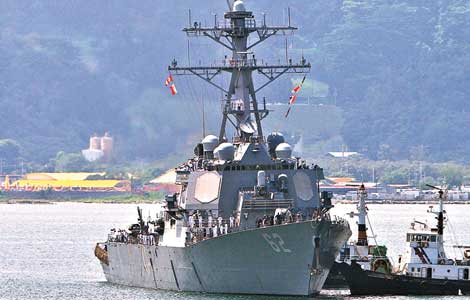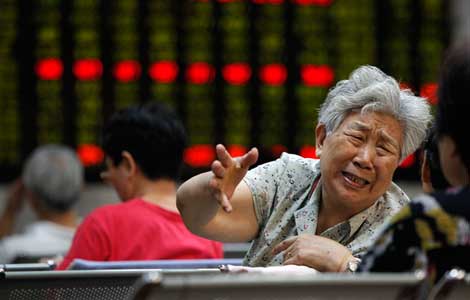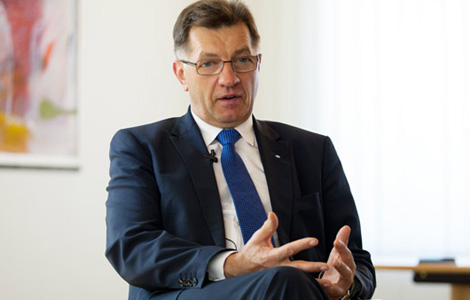SOEs overseas profits to soar
Updated: 2013-07-30 11:29
By Bao Chang in Beijing and Zhang Yuwei in New York (China Daily)
|
||||||||
Half of central government State-owned enterprises' profits will come from their overseas operations in the next five years, compared with less than 38 percent at present, according to a State-owned assets watchdog.
"We will focus on the structure of corporate profits when we evaluate central SOEs' international operations in the next few years," said Liu Nanchang, director of the Performance Evaluation Bureau of the State-owned Assets Supervision and Administration Commission.
The SOEs' international networks and business scale will also be key criteria in the assessment, he added.
The target can be achieved through better allocation of resources, choice of market, brand-building and industrial upgrading, rather than asset acquisition, experts say.
"China's SOEs have become increasingly profitable and economically dominant since the 2008 global financial crisis. It should come as little surprise that such a profitable area of China's economy would," said Jon Taylor, a professor of political science at the University of St. Thomas in Houston.
Taylor said the SOEs' expansion of their investment portfolio - beyond traditional industries such as energy and raw materials - has also contributed to this increase.
"That has begun to change as Chinese firms SOEs have focused on both emerging and developed markets, with the goal of acquiring brands, technologies, and markets for Chinese goods," said Taylor.
New York-based consulting group Rhodium Group said that Chinese investment in the US totaled $6.7 billion last year. Although with some political pressure in the US, which led to a drop in Chinese SOE's investment, the largest Chinese state-owned energy companies - Sinopec, CNOOC, CNPC and Sinochem - have put significant capital into the development of unconventional oil and gas resources, according to Rhodium.
"The value of Chinese direct investment in the US is very modest, representing just 0.1 percent of all foreign direct investment in the US. That has to improve if the US is to really become a hotspot of Chinese SOE investment," said Taylor.
The misconception of the SOEs also contributed to its investment volume in overseas markets. Experts say that there are quite a number of challenges for SOEs to overcome before realizing high numbers.
Julian Chang, executive director of the Ash Center at Harvard Kennedy School, said the biggest challenge for SOEs in overseas markets is to overcome the "China, Inc" label.
"It took Japanese companies many years, much effort and lots of mistakes to get to the position where people stopped worrying about a 'Japan, Inc'", said Chang. "It will be harder for Chinese companies to overcome this challenge without some serious thinking about how to describe the nature of their business and their relationship to their investors, public or private."
Taylor shares this view.
"My advice would be for Chinese SOEs to be prepared to become more 'Americanized', adapting to both US business practices as well as consumer choices and preferences, much like American businesses doing business in China," he explained.
"Openness to Chinese foreign investment would benefit the US by generating jobs, facilitating innovation and investment in new technologies, and strengthening US manufacturing," he added.
Since 2003, when the commission was formed, it has carried out annual reviews of the performance of central SOEs and their leaders.
At the start of the nation's 12th Five-Year Plan (2011-15), the commission made it a top priority to develop central SOEs into top multinationals globally.
Forty-four central SOEs are listed on the Fortune Global 500 in 2013, with China Petrochemical Corp, China National Petroleum Corp and State Grid Corp in the top 10.
The Fortune Global 500 is an annual ranking of the top 500 corporations worldwide, measured by revenue. It is compiled and published by Fortune magazine.
Liu said: "We plan to take five to 10 years to allocate the major part of central SOEs' resources in global markets.
"We will spare no effort to promote international competitiveness of the central SOEs, which are requested to withdraw from low-end industrial chains and concentrate on premium overseas markets."
Overseas assets of Chinese companies, which have more than 15,000 branches worldwide, are valued at more than $1 trillion, with half coming from State-owned enterprises, according to the commission.
But compared with their foreign counterparts, the overseas business of Chinese enterprises still accounts for a relatively small proportion, according to Kang Yan, senior partner at Roland Berger Strategy Consultants of Shanghai.
He attributes this to a lack of motivation. While Japanese and South Korean companies have faced shrinking domestic markets, Chinese enterprises have generated large profits from the domestic market in recent years, making them less eager to tap the international market, according to Kang.
Samsung Electronics began its internationalization drive as early as the 1970s by continuously establishing sales networks and production bases in major markets such as the US, the UK, Mexico and China.
As a result, Samsung accounted for 23.6 percent of the world market for mobiles in the first quarter of this year, the leading position globally, according to US market research firm Gartner Inc.
China National Petroleum Corp, with assets worth more than 3 trillion yuan ($488.7 billion), overtook Exxon Mobil and Royal Dutch Shell in value last year. But its overseas revenue accounted for only 20 percent of its total income, compared with about 70 percent for Exxon Mobil and Shell.
Huang Shuhe, the commission's vice-chairman, said earlier that Chinese SOEs should follow the example of major multinationals in their global expansion.
Contact the writers at baochang@chinadaily.com.cn and yuweizhang@
chinadailyusa.com
(China Daily USA 07/30/2013 page1)
Most Viewed
Editor's Picks

|

|

|

|

|

|
Today's Top News
China, US will discuss human rights
SOEs overseas profits to soar
Apple in labor rights inquiry
Former US president plans to visit DPRK
China struggles to retain talents
Families of crash victims to sue Asiana in the US
Detroit: Gold mine for China
Major SOEs eye profits from abroad
US Weekly

|

|















